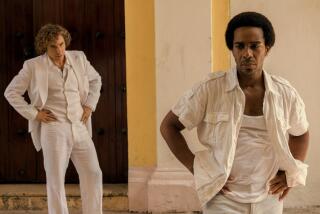Is ‘The Little Prince’ a faithful adaptation? A radical reworking? A tribute? Well, yes
- Share via
Once upon a time, there was a man with a magic suitcase. And a nervous stomach.
“The queasiness happened at the very outset,” says Mark Osborne, who conceived and directed the animated adaptation of Antoine de Saint-Exupéry’s “The Little Prince.” “I wanted to come up with something that wasn’t just an adaptation, but a tribute to the power of the book and its power all over the world.”
To call the 1943 novella “beloved” would qualify as an understatement. It has sold more than 140 million copies in more than 250 translations.
The script’s co-writer, Irena Brignull, says, “Reading it again, I was surprised at how grown-up it was – I hesitate to use ‘grown-up’ because of its connotations in the book – there’s a lot of meaning packed into such a tiny volume.”
Indeed, “Little Prince” is deceptively simple, the story of a cosmically traveling boy and his encounters with love, loss and notions of growing up in the forms of a fragile-yet-demanding rose, a philosophical fox and a series of adults trapped in their own self-images. All this is told by a narrator whose plane went down in a desert, where he met the cosmic boy.
There’s no way to adapt a book and make everybody happy. That ended up freeing me in a way. But I’d be lying if I said I didn’t have sleepless nights.
— Mark Osborne
“There’s no way to adapt a book into a movie and make everybody happy,” says Osborne. “That ended up freeing me in a way. But I’d be lying if I said I didn’t have cold sweats and sleepless nights.”
They boldly chose to contain De Saint-Exupéry’s text inside a story within a story. In Osborne’s adaptation, “The Little Girl” moves in next door to a strange old man, “The Aviator.” Suffocating in an over-regimented life, the Little Girl is drawn to the Aviator’s tale.
“The idea of the life plan” the Little Girl’s mother uses to rigidly define her daughter’s life, says Brignull, “which we exaggerated and heightened, came from a conversation I had with one of my kids’ friends. It seemed to capture how we overstructure our kids’ lives … it seemed in complete antithesis to the spirit of the book.”
The film distinguishes the worlds of the Little Girl and the Little Prince with distinct animation techniques. The Little Girl’s world is in state-of-the-art digital imagery.
Osborne says, “If we let the book be in stop-motion, small and poetic, that’s actually true to it. It’s a faithful adaptation nestled inside a celebration of the book.”
Jamie Caliri, who oversaw the film’s stop-motion animation, crafted beautiful sequences using paper and real light. They burst with imagination and painstaking detail, such as the ornate paper construction of the Fox.
Osborne says the film uses “4 1/2” animation techniques: “We start in hand-drawn animation, then there’s full CG; the third technique is cut-outs – when we go into the Little Girl’s imagination, it’s all cut-out, it’s very flat, like a multiplane; and then when the Little Prince appears, that’s the first time we see dimensional puppets. The half technique, we actually incorporated hand-drawn into the CG when the Little Girl is holding the sheep drawings and we see them moving.”
None of this could have happened, of course, if Osborne hadn’t been able to sell his unusual vision.
“The Magic Suitcase is this crazy thing, a way to pitch it to people. I had an art book I used to tell people the story. It was in a suitcase that was handmade and was a beautiful work of art in itself. Inside was this constellation of stars and planets and these 3-D slide viewers. There’s all sorts of interesting things that made people put their phones away.
“That Magic Suitcase has been all over the world. Jeff Bridges [who voices the Aviator] – I took it to his house and I think it was a big part of why he agreed to be involved. To Hans Zimmer [who co-composed the music], I brought it in, I had about 10 minutes to sell him. He said, ‘What is that?’ He was very much a fan of the book; his attitude was very much, ‘What are you doing to my book?’ We ended up spending 2 1/2 hours together.”
They apparently lived happily ever after: Osborne’s vision has been embraced (93% on Rotten Tomatoes) and has grossed $98 million worldwide despite virtually no theatrical distribution stateside (it’s available on Netflix).
“The hope was we might direct people back to the book, and then they could experience it for themselves,” says Brignull.
For Osborne, “I wanted the movie to feel like you’re having a dialogue with your friend, this Little Girl, about the way she interprets this story. And you don’t have to see it exactly the same way.”
See the most read stories this hour »
ALSO:
Animated films draw on all aspects of life
‘Kubo’ tackles deep issues within its dream-like tale
‘Zootopia’ and ‘Kubo’ lead Annie Awards nominations
Lessons on bias and prejudice dwell within the world of ‘Zootopia’
More to Read
From the Oscars to the Emmys.
Get the Envelope newsletter for exclusive awards season coverage, behind-the-scenes stories from the Envelope podcast and columnist Glenn Whipp’s must-read analysis.
You may occasionally receive promotional content from the Los Angeles Times.










